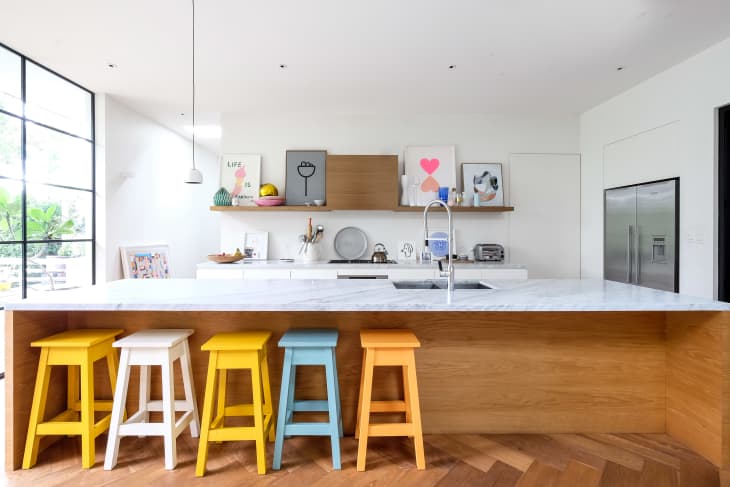6 Smart Tips for Adding Color to Your Kitchen, According to Interior Designers
Introducing color to any space is a balancing act between too much and too little, and over-the-top hues and tones that fall flat. But get it right and the benefits are so worth it. Color can instantly liven up a space — especially in the kitchen, a room where meals are lovingly made and recipes are discovered. Color can provide creative inspiration or just make the space so pretty you’ll want to cook more.
Ready to take on a color refresh but not sure where to start? We tapped two interior designers for their expert advice on how to easily infuse color into the heart of the home — whether you’re looking for something moody, vibrant, soothing, or showy.
1. Use the 60-30-10 color rule.
A good place to start is the 60-30-10 color rule, says designer and Midcity Design Group founder, Tiffany White. “[It] is a timeless design tool to help you put a balanced color scheme together,” she explains.
The rule states that your main room color should comprise 60 percent of the room, your secondary color should comprise 30 percent, and your accent color should comprise 10 percent. In a space like the kitchen, the 60 percent will likely include most of your walls, and large pieces like the island or hood. The secondary color can apply to drapes, stools, or even an accent wall. Meanwhile, the accent color can come through in cooking appliances or artwork.
2. Consider your space.
Look to the architecture of your kitchen for cues. Certain features can help determine what colors to utilize and the visual effect they will play, says White. “The application of colors on surfaces influences your perception of the space,” she notes. “For example, if you incorporate an arch on a wall in a room and paint, tile, or wallpaper the interior of the arch a color different [from] the exterior of the arch, [it] will take a 3-dimensional form.”
3. Make a statement with your surfaces.
Kitchen surfaces are a great place to make a statement, according to White. “[They] offer an opportunity to experiment,” she says. “Choose from colored marbles, backlit slabs, terrazzo, and pigmented concrete.” White’s favorite? “A sapphire blue herringbone backsplash.”
Cathie Hong, principal and founder of Cathie Hong Interiors, agrees: “If you’re a risk-taker, you can also choose a statement-colored stone for the countertops or backsplash, which is a great way to bring in color and some natural pattern.”
Cabinets are also an apt area to infuse color, says Hong. “If it’s too intimidating to make all of the cabinets one bold color, you can opt for just the island or the wall cabinets as an accent color,” she suggests.
And don’t forget about your floors and walls, notes White. Colorful patterns can also be applied to the floors or walls through decorative tiling, wallpaper, or even muraling if you’ve got an artist’s touch.
4. Consider a monochromatic palette.
Looking for a more subtle color scheme? You can always go for a monochromatic palette, suggests White. “Color schemes within the same hue or tone family can be your guide,” she explains. “For instance, if you prefer BM Vintage Vogue Green as your primary color, you can vary the shade using a combination of a lighter green, Aganthus Green, and deeper green, Essex Green.”
5. Get colorful with your accessories.
The kitchen is full of opportunities to accessorize — and showcase personality. “We always encourage our clients to style their kitchens to make the space feel more complete,” notes Hong. “If the kitchen is very neutral, it can be fun to add in colorful kitchen linens, vases, ceramics, and, of course, flowers.”
Other accessories like towels, bowls, and utensils are also clever ways to add a pop of color, says White. “Keurig and KitchenAid have the right idea with colored coffee makers and mixers,” she adds. “But we’re in a new age. Colored knobs, handles, and fixtures are an up-and-coming trend that I predict we’ll see more of.”
6. Try before you commit.
In an ideal world, you’ll want to try out your colors before going all in. “We always present samples of the materials in the space that they will reside so we can see how those colors look in the type of lighting they get in those rooms,” explains Hong. “We also encourage our clients to study the colors as the light shifts throughout the day, to make sure that the tone and color is what they’re looking for all day long, not just in the morning or evening.”
To do it yourself, you can obtain paint and fabric samples from most homeware stores — or online — for a small fee.
